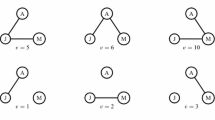Abstract
We propose a network formation model using the theory of stochastic games with random terminal time. Initially, the leader proposes a joint project in the form of a network to the players. Then the players have opportunities to form new links with each other to update the network proposed by the leader. Any player’s payoff is determined at any step by the network structure. It is also assumed that the formation of the links proposed by the players is random. The duration of the game is random as well. As a result of the players’ actions and the implementation of random steps of the Nature, a network is formed. We consider a cooperative approach to network formation and use the CIS-value as a cooperative solution. In this paper, we obtain a recursive formula to derive this value in any cooperative subgame. The paper also investigates the dynamic consistency of the CIS-value. The theoretical results are illustrated by a numerical example.



Similar content being viewed by others
REFERENCES
Gromova, E.V. and Petrosyan, L.A., On an approach to constructing a characteristic function in cooperative differential games, Autom. Remote Control, 2017, vol. 78, no. 9, pp. 1680–1692.
Mazalov, V.V. and Chirkova, Yu.V., Setevye igry (Network Games), St. Petersburg: Lan’, 2018.
Petrosyan, L.A., Stability of solutions in differential games with many players, Vestn. Leningr. Univ. Ser. 1: Mat. Mekh. Astron., 1977, no. 19, pp. 46–52.
Petrosyan, L.A. and Danilov, N.N., Stability of solutions in nonzero-sum differential games with transferable payoffs, Vestn. Leningr. Univ. Ser. 1: Mat. Mekh. Astron., 1979, no. 1, pp. 52–59.
Petrosyan, L.A. and Sedakov, A.A., Multistage network games with perfect information, Autom. Remote Control, 2014, vol. 75, no. 8, pp. 1532–1540.
Petrosyan, L.A., Sedakov, A.A., and Bochkarev, A.O., Two-stage network games, Autom. Remote Control, 2016, vol. 77, no. 10, pp. 1855–1866.
Aumann, R.J. and Myerson, R.B., Endogenous formation of links between players and of coalitions: an application of the Shapley value, in The Shapley Value, 1988, pp. 175–191.
Aumann, R.J. and Peleg, B., Von Neumann–Morgenstern solutions to cooperative games without side payments, Bull. Am. Math. Soc., 1960, vol. 66, no. 3, pp. 173–179.
Avrachenkov, K.E., Kondratev, A.Y., Mazalov, V.V., and Rubanov, D.G., Network partitioning algorithms as cooperative games, Comput. Soc. Networks, 2018, vol. 5, no. 1, article ID 11.
Bala, V. and Goyal, S., A noncooperative model of network formation, Econometrica, 2000, vol. 68, no. 5, pp. 1181–1229.
Chander, P. and Tulkens, H., The core of an economy with multilateral environmental externalities, in Public Goods, Environmental Externalities, and Fiscal Competition, Boston, MA: Springer, 2006, pp. 153–175.
Driessen, T.S.H. and Funaki, Y., Coincidence of and collinearity between game theoretic solutions, OR Spektrum, 1991, vol. 13, pp. 15–30.
Gao, H., Petrosyan, L., Qiao, H., and Sedakov, A., Cooperation in two-stage games on undirected networks, J. Syst. Sci. Complexity, 2017, vol. 30, no. 3, pp. 680–693.
Gao, H., Petrosyan, L., and Sedakov, A., Dynamic Shapley value for repeated network games with shock, 27th Chin. Control Decis. Conf. (2015 CCDC) (2015), pp. 6449–6455.
Gromova, E.V. and Plekhanova, T.M., On the regularization of a cooperative solution in a multistage game with random time horizon, Discrete Appl. Math., 2019, vol. 255, pp. 40–55.
Haurie, A. and Zaccour, G., Differential game model of power exchange between interconnected utilities, Proc. IEEE Conf. Decis. Control (1986), pp. 262–266.
Jackson, M.O. and Watts, A., On the formation of interaction networks in social coordination games, Games Econ. Behav., 2002, vol. 41, no. 2, pp. 265–291.
König, M.D., Tessone, C.J., and Zenou, Y., Nestedness in networks: a theoretical model and some applications, Theor. Econ., 2014, vol. 9, no. 3, pp. 695–752.
Kuzyutin, D., Gromova, E., and Smirnova, N., On the cooperative behavior in multistage multicriteria game with chance moves, in Mathematical Optimization Theory and Operations Research. MOTOR 2020. Lecture Notes in Computer Science, vol 12095, Kononov, A., Khachay, M., Kalyagin, V., and Pardalos, P., Eds., Cham: Springer, 2020, pp. 184–199.
Von Neumann, J. and Morgenstern, O., Theory of Games and Economic Behavior, Princeton, NJ: Princeton Univ. Press, 1947.
Parilina, E., Solutions of cooperative stochastic games with transferable payoffs, Doctoral (Phys.-Math.) Dissertation, 2018.
Parilina, E.M., A survey on cooperative stochastic games with finite and infinite duration, Contrib. Game Theory Manage., 2018, vol. 11, no. 0, pp. 129–195.
Parilina, E. and Petrosyan, L., On a simplified method of defining characteristic function in stochastic games, Mathematics, 2020, vol. 8, no. 7, article ID 1135.
Parilina, E.M. and Tampieri, A., Stability and cooperative solution in stochastic games, Theory Decis., 2018, vol. 84, no. 4, pp. 601–625.
Parilina, E.M. and Zaccour, G., Node-consistent Shapley value for games played over event trees with random terminal time, J. Optim. Theory Appl., 2017, vol. 175, pp. 236–254.
Petrosyan, L. and Zaccour, G., Time-consistent Shapley value allocation of pollution cost reduction, J. Econ. Dyn. Control, 2003, vol. 27, no. 3, pp. 381–398.
Pin, P. and Rogers, B., Stochastic network formation and homophily, in Oxford Handbook on the Economics of Networks, Bramoullé, Y., Galeotti, A., and Rogers, B., Eds., Oxford: Oxford Univ. Press, 2016.
Reddy, P.V. and Zaccour, G., A friendly computable characteristic function, Math. Soc. Sci., 2016, vol. 82, pp. 18–25.
Shapley, L.S., Stochastic games, Proc. Natl. Acad. Sci., 1953, vol. 39, no. 10, pp. 1095–1100.
Sun, P. and Parilina, E., Two-stage network formation game with heterogeneous players and private information, Contrib. Game Theory Manage., 2019, vol. XII, pp. 316–324.
Funding
The work was funded by Shandong Province “Double-Hundred Talent Plan” (No. WST2017009).
Author information
Authors and Affiliations
Corresponding authors
Additional information
Translated by V. Potapchouck
Rights and permissions
About this article
Cite this article
Ping Sun, Parilina, E.M. Stochastic Model of Network Formation with Asymmetric Players. Autom Remote Control 82, 1065–1082 (2021). https://doi.org/10.1134/S0005117921060072
Received:
Revised:
Accepted:
Published:
Issue Date:
DOI: https://doi.org/10.1134/S0005117921060072




